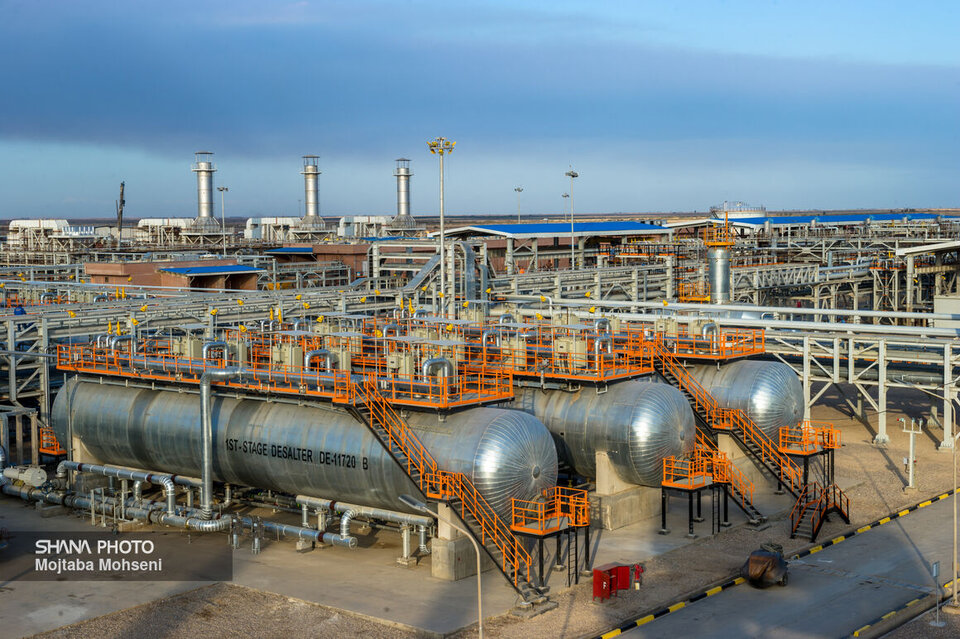Preserved and enhanced oil recovery constitutes the main development project undertaken by NISOC in the aftermath of the 1979 Islamic Revolution. Spanning five southwestern provinces, the projects are prioritized by Petroleum Ministry and National Iranian Oil Company (NIOC). The primary objective of this projects is to ramp up oil output by 341 tb/d, which would materialize with the development of 28 reservoirs operated by NISOC.
Supporting domestic manufacturing by requiring contractors to use domestically-manufactured equipment and development of the surrounding regions by allocating 4% of the project's credit to social responsibility is another goal of the project.
$4.3bn Investment
In terms of the amount of investment, this project is considered the largest field development project in Iran’s southern oil regions, consisting of 27 contract packages with an estimated investment of more than $4.3 billion relying on the capabilities of domestic companies.
Achieving the outlined goals in line with the mission and vision of the Petroleum Ministry, increasing NISOC’s maximum efficient recovery, optimal management of production costs by using appropriate and advanced technologies, renovation and reconstruction of existing facilities, use of well-oriented technologies in order to increase the flow rate of the wells, use of facility-based technologies in order to optimize and enhance the production and processing capacity of oil and gas, constitute one of the goals of this national plan.
Project Screening
What is the current status of the development plan of 28 oil reservoirs? What has happened so far in the development plan of 28 reservoirs is related to 26 reservoirs because one reservoir still does not have the permission of the Economic Council and a contract has not yet been concluded for one reservoir.
Contracts have been signed for the 26 reservoirs in different ways since March 2019 until December 2021.
“In NISOC, we have put all these projects to a general screening. We required all contractors to meet their obligations. On the other hand, we also feel compelled to honor our obligations set forth in these contracts,” said Daneshi.
Nonetheless, in the process of implementation of projects, some contractors had weaknesses and they were helped to overcome them.
42 Wells Drilled
Currently, 24 drilling rigs are operational in the 26 reservoirs. So far, 42 wells have been drilled while 20 more are being drilled. Furthermore, 8 wells have been worked over and one well is being worked over.
Well No. 6 of the Kaboud field in the Bangestan reservoir is the first well spudded for boosting the output capacity. The well struck oil last April with a flow of 1 tb/d.
The achievements from the successful drilling of Well No. 6 of the Kaboud field include gathering maximum new information about the extent and dimensions of the reservoir, studying the output capacity of Ilam Formation of the Bangestan reservoir of the Kaboud field, complying with environmental obligations, management of wastes and NISOC’s transfer of knowledge and experience to private oil firms.
According to planning made, it was decided that by introducing structural changes into NISOC and redistributing employer forces, the projects could be accelerated. Furthermore, such working groups as the Financial and Commodity Working Group were established to explore and resolve problems fundamentally. In addition to these projects, negotiations with foreign investors are also nearing finalization.
Thanks to the NISOC efforts, the three projects of Nargesi, Kaboud and Lali Asmari are nearing completion.
Eleven contacts involving Ahvaz 1&4, Ahvaz 2&3&5, Maroun 2&5, Maroun 1&4, Maroun 6, Siah Makan, Mansourabad, Solabdar, Binak, Bibi Hakimieh and Golkhari had some problems which NISOC managed to resolve thanks to its coherent planning.
Forex rate fluctuations have occurred during the implementation of these projects. This issue has been raised with the Management and Planning Organization (MPO).
Gas Gathering Station
The 28 reservoirs are located in the provinces of Khuzestan, Bushehr, Kohguiluyeh and Boyer Ahmad, Fars and Ilam. The bulk of work is in Khuzestan Province. The requirement for using domestically manufactured commodities, allocation of 4% to social responsibility, hiring local manpower and complying with environmental obligations are among the outstanding features of the project.
These projects require 124 surface projects and 651 well stimulation operations. Furthermore, 100 surface projects including construction of oil pipelines and pumping stations with a budget allocation of $230 million would be implemented. Regarding gas and liquefied petroleum gas equipment, a gas gathering station valued at $650 million would be established.
One of the outstanding features of this project is gathering associated petroleum gas and reducing environmental impacts. Furthermore, 15% of drilling costs goes to zero discharge projects by spending several hundred million dollars.
“NISOC will spare no effort with regard to the implementation of these projects. It even provided some commodities supplied with hardship to these contractors so that the projects would not be halted,” said Daneshi.
He said that some projects were modified mid-way, while some others went ahead as planned.
The supervisory model developed by the former administration had changed the structure of regions, which slowed down work. But with some modifications in the process of implementation, the projects were back on the right track and currently NISOC’s Directorate of Engineering and Construction is pursuing these projects.
Expelling Unqualified Contractors
Four projects were cancelled with contractors after they later said they could no longer handle them. They involve development of Gachsaran Khami and Ramin, Zilaei, Chalingar and Garangan. They would be awarded to new contractors soon.
NISCO is ready to put these projects out to tender immediately.
According to Daneshi, the subsurface section of these projects is satisfactory, but contractors face a variety of problems and challenges on the surface specifically in the commodity supply and payments.
Courtesy of Iran Petroleum


Your Comment